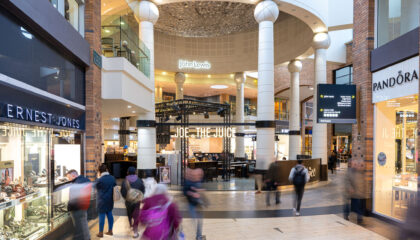If retail had been dying a slow death before the arrival of Covid-19, the pandemic has done nothing to provide life support. With working from home set to double after the crisis, and a massive increase in online shopping already enshrined in consumer behaviour, up to 400,000 retail jobs are now at risk, says KPMG.
However, the predicted drop in commuter numbers, combined with a trend towards suburban home moves, has led to a bright spot on the horizon in one specific retail sector: the out-of-town retail park.
In the five weeks to 2 January 2021, overall footfall at UK shopping destinations dropped 46% compared to the previous year. This encompassed a drop of 50% at high streets and 47% at shopping centres. Yet at retail parks the slip in footfall was not so keenly felt, at just 17% lower than the previous year, according to BRC-ShopperTrak. For the week prior to Christmas 2020, customer visits to retail parks had dropped by only 8% compared to the same week in 2019.
Across the 150+ portfolio of Workman-managed retail parks, visitor numbers were down by just 7% in December 2020 compared to December 2019, and were only 14% less for the entire 2020 calendar year.
Retail parks attract investors
This resilience hasn’t gone unnoticed by investors, who ended 2020 with a flurry of retail park acquisitions, and began 2021 in the same vein. Earlier this month, Federated Hermes completed a £45m deal to purchase a retail park in Oxford, while Columbia Threadneedle acquired Durham City Retail Park for £27m from Aviva Investors and Flowerdown Retail Park in Weston-Super-Mare for £22m from BlackRock UK Property Fund. The transactional activity has also been driven by Clearbell and Tritax, among others.
Appetite from investors for out-of-town retail is riding not only on the sector’s ability to weather lockdowns, but also to attract shoppers post-pandemic. A major factor in the comparative success of out-of-town retail parks has been a sense of safety. The ability to arrive and leave in their own cars, take advantage of ample free parking, the simplicity of social distancing within far larger units, along the open-air aspect, means shoppers will likely feel more comfortable than in other environments.
And retail parks are not just being snapped up with the intention of repurposing into last mile distribution centres or residential. Most have attracted investment due to their broad base of essential retailers, with a perceived lower risk of insolvency.
Essential retailers’ profits soar
With a strong weighting to food, homeware and other provisions deemed essential, retail parks were able to continue trading where others have had to cease during lockdowns. Robust trading figures are obviously expected from the supermarkets, but these are mirrored by other essential retailers such as Halfords, where unprecedented levels of demand have seen bike sales rocket. The company expects half-year profits to top £55m, compared with the £35m it had been predicting.
Similarly, Pets at Home, boosted by demand for pets as a result of increased home-working, saw sales continue to soar at its 451 stores. Considered an essential retailer, the company’s pre-tax profits jumped by 14% to £38.9m for the six months to 8 October 2020.
Likewise, the growth of discounters such as The Range, B&M and Home Bargains continues strongly, with these retailers well-placed as customers tighten their budgets in recessionary times. Prior to Lockdown 3, homeware and furniture retailers such as Dunelm and DFS – now not deemed essential retailers – had reported sales growth above 20% compared to 2019. Homeware, alongside DIY and trade warehouses B&Q, Homebase and Wicks, is predicted to experience further growth as customers continue to invest in their homes.
The click-and-collect factor
Retailers including Currys PC World, B&Q and Dunelm have benefitted from their ability to pivot to click-and-collect: a method well-suited to out-of-town retail sites due to ease of deliveries and logistics, provision of dedicated parking bays, general abundance of space and ease of access to warehouse stock. The retail park unit is typically 10,000 sq. ft and able to take deliveries of stock directly through the rear doors via dedicated service yards, while shopping centre units are obviously typically much smaller and often remote from delivery and storage facilities.
And when click-and-collect has been allowed, Workman has partnered with retailers to enable them to provide it. Alongside Activate, the Workman placemaking and marketing division, our team have revised online and marketing strategies to ensure these assist retailers and are appropriately targeted to the local market. Towards the end of last year, with fast-moving changes to local tiers, the ability to leverage this joined-up approach and interact with customers via social media was critical.
Shopping has also become more purposeful during Covid times, which has played neatly into the hands of out-of-town retailers, where visits are usually borne out of clear intent. In the future, this resilience and attractiveness may mean that these out-of-town parks attract new and different kinds of retailers, as seen with Next and Primark in previous years. And, if consumers feel more confident shopping at retails parks, then it’s clear that investors will feel they are a safer bet too.
With the resilience of out-of-town parks proving highly attractive to institutional investors, property companies and private equity, the sector may glow with vigour in an otherwise clouded retail landscape.
By Nick Hilton, Partner, Workman Retail & Leisure



